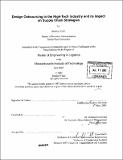| dc.contributor.advisor | Donald Rosenfield. | en_US |
| dc.contributor.author | Vakil, Bindiya | en_US |
| dc.contributor.other | Massachusetts Institute of Technology. Engineering Systems Division. | en_US |
| dc.date.accessioned | 2006-07-13T15:22:41Z | |
| dc.date.available | 2006-07-13T15:22:41Z | |
| dc.date.copyright | 2005 | en_US |
| dc.date.issued | 2005 | en_US |
| dc.identifier.uri | http://hdl.handle.net/1721.1/33418 | |
| dc.description | Thesis (M. Eng. in Logistics)--Massachusetts Institute of Technology, Engineering Systems Division, 2005. | en_US |
| dc.description | Includes bibliographical references (leaves 131-135). | en_US |
| dc.description.abstract | The practice of outsourcing product design to a service provider is prevalent in fast-moving high-tech electronics. Product design affects all subsequent activities such as procurement, manufacturing, logistics and after-sales services. Thus, companies do design for supply chain (DFSC), which is the process of designing products by incorporating such supply chain considerations as supplier selection and integration, single vs. multi-sourcing, component commonality, postponement, variety management, product reuse and recycling, planned obsolescence, etc. Each of these strategies involves tradeoffs which become difficult to evaluate in an outsourced environment. The levels at which companies engage with their service provider such as fully outsourced or joint design, affect the degree of control they can exercise over the design process. The main finding is that when products are fully outsourced, companies have less control and therefore, a lower possibility of implementing DFSC. Certain measures are proposed whereby companies may influence DFSC implementation even in fully outsourced design. When some of the design is kept in-house in a joint design model, the level of control is high. | en_US |
| dc.description.abstract | (cont.) Another important finding is that design service providers actually achieve excellence in incremental innovation and do implement DFSC strategies which have cost-saving and revenue-generating benefits for them. The distribution of the resultant savings is primarily a function of the company's ability to understand the service providers' cost structure and its negotiating power in the relationship. Two case-studies are included of products where different outsourcing levels are used and the impact of the level of outsourcing is studied for each supply chain strategy. | en_US |
| dc.description.statementofresponsibility | by Bindiya Vakil. | en_US |
| dc.format.extent | 139 leaves | en_US |
| dc.format.extent | 8008808 bytes | |
| dc.format.extent | 8014627 bytes | |
| dc.format.mimetype | application/pdf | |
| dc.format.mimetype | application/pdf | |
| dc.language.iso | eng | en_US |
| dc.publisher | Massachusetts Institute of Technology | en_US |
| dc.rights | M.I.T. theses are protected by copyright. They may be viewed from this source for any purpose, but reproduction or distribution in any format is prohibited without written permission. See provided URL for inquiries about permission. | en_US |
| dc.rights.uri | http://dspace.mit.edu/handle/1721.1/7582 | |
| dc.subject | Engineering Systems Division. | en_US |
| dc.title | Design outsourcing in the high-tech industry and its impact on supply chain strategies | en_US |
| dc.type | Thesis | en_US |
| dc.description.degree | M.Eng.in Logistics | en_US |
| dc.contributor.department | Massachusetts Institute of Technology. Engineering Systems Division | |
| dc.identifier.oclc | 62763418 | en_US |

